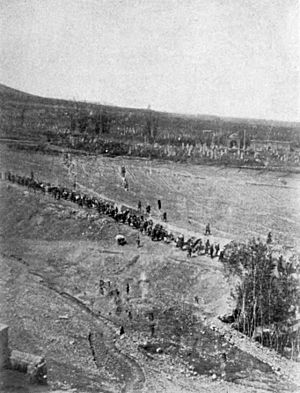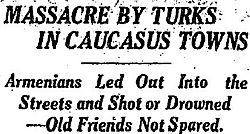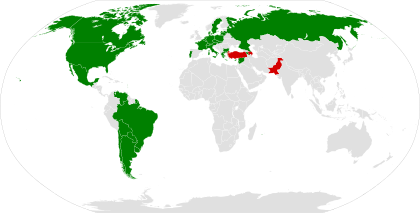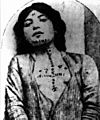Armenian Genocide facts for kids
Quick facts for kids Armenian genocide |
|
|---|---|
| Part of World War I | |

Armenian people being moved from their homes in Harput
|
|
| Location | Ottoman Empire |
| Date | 1915–1917 |
| Target | Armenians in the Ottoman Empire |
|
Attack type
|
Genocide, death march, forced change of religion |
| Deaths | 600,000–1.5 million |
| Perpetrators | Committee of Union and Progress |
| Trials | Ottoman Special Military Tribunal |
The Armenian genocide was a terrible event where many Armenian people were forced to leave their homes and were killed. This happened from 1915 to 1917 in the Ottoman Empire. At that time, the empire was ruled by a group called the Young Turks.
Contents
Planning the Events
In November 1914, the Ottoman Empire joined World War I. They fought alongside the Central Powers. The Minister of War, İsmail Enver, led a military attack against Russian forces. This attack was in the Caucasus region. His plan was to capture the city of Baku. However, his army lost badly at the Battle of Sarikamis. Many of his soldiers froze to death.
When Enver returned to Istanbul, he largely blamed the Armenians. He said they had helped the Russians. Even though there were some tensions, Armenians had generally done well under Ottoman rule. Many Armenians were better educated and wealthier than their Turkish neighbors. This caused some jealousy. There were also worries that Christian Armenians would support other Christian governments, especially Russia. Russia shared a border with the Ottoman Empire.
In 1914, the Ottoman War Office started spreading messages. They said Armenians were a danger to the empire's safety. The government quickly acted. On April 24, 1915, they arrested about 250 Armenian thinkers and leaders. This day is often seen as the start of the genocide. The terrible acts against Armenians continued for several years.
Armenians still remembered earlier attacks. These had happened in 1894, 1895, 1896, and 1909.
Actions Taken by Turks
Around 1915-1916, Armenians were forced out of their homes. Turks then took over these homes. As part of a plan to make everyone more Turkish, government groups took Armenian children. They forced these children to become Muslim and gave them to Turkish families. In some places, Armenian women were forced to join Turkish families or work as servants. Muslim families moved into the homes of Armenians who had been forced to leave. They took their property.
At the same time, the Turks created a 'Special Organization'. This group then set up 'killing squads'. These squads were meant to remove "Christian elements," as one officer said. The killing squads often included people who had been in prison for serious crimes.
What Others Saw
"I am confident that the whole history of the human race contains no such horrible episode as this. The great massacres and persecutions of the past seem almost insignificant when compared with the sufferings of the Armenian race in 1915." Henry Morgenthau, American ambassador to the Ottoman Empire, 1913-1916. -Henry Morgenthau
Henry Morgenthau was the American ambassador to the Ottoman Empire. He saw what was happening. He said that the suffering of the Armenian people in 1915 was worse than anything else in human history.
Disagreement About the Killings
Some people, like Guenter Lewy, have written books about these events. Lewy claims in his book, The Armenian Massacres in Ottoman Turkey: A Disputed Genocide, that there isn't enough proof. He says the Young Turk government did not plan the killings of Armenians. He believes it was not a "real" genocide. This is because he thinks there was no central plan by the government to destroy the Armenian people.
A big reason why the genocide is not fully recognized worldwide is Turkey's official view. Turkey says there was no planned effort to wipe out the Armenian population. They say the 1915 killings happened because of a law called the Tehcir Law and because of the war. In December 2008, some Turkish scholars started an online petition. People could sign it to apologize for what happened. However, they did not use the word "genocide." Instead, they used "the Great Catastrophe." Many Turks saw Armenians as a threat during wartime. They argued that people from many different groups were killed during the violence. Turkey and its leaders worry that recognizing the word "genocide" could lead to large payments for damages. It could also cause public shame.
Countries That Recognize It
Many Armenian people who live outside Armenia have worked hard for countries to officially recognize the Armenian genocide. This has become a very important goal for them. For a long time, many countries avoided recognizing it. They wanted to keep good relations with Turkey. As of 2022, 31 countries have recognized the genocide. Pope Francis and the European Parliament have also recognized it.
How Culture Shows It
After meeting Armenians who survived, an Austrian-Jewish writer named Franz Werfel wrote a book. It was called The Forty Days of Musa Dagh (1933). This book was a fictional story about an Armenian uprising. It was also a warning about the dangers of Nazism. This book is considered very important. It is still read by Armenians around the world. The genocide also became a main topic in English books written by Armenian-American writers.
The first movie about the Armenian genocide was Ravished Armenia. It came out in 1919. It was made to raise money for Near East Relief. The movie was based on the true story of Aurora Mardiganian, who played herself. Since then, more movies about the genocide have been made. However, it took many years for these films to reach a lot of people. The paintings of Arshile Gorky were also shaped by his experience of the genocide. More than 200 memorials have been built in 32 countries to remember this event.
Gallery
-
The Armenian quarter of Adana after the 1909 massacres
-
Çankaya Mansion, the official residence of the president of Turkey, was confiscated from Ohannes Kasabian, an Armenian businessman, in 1915.
-
Aerial view of the Armenian Genocide memorial complex on a hill above Yerevan
Related pages
- Pontic Greek Genocide
- Adana massacre
- Hamidian massacres
See also
 In Spanish: Genocidio armenio para niños
In Spanish: Genocidio armenio para niños

















